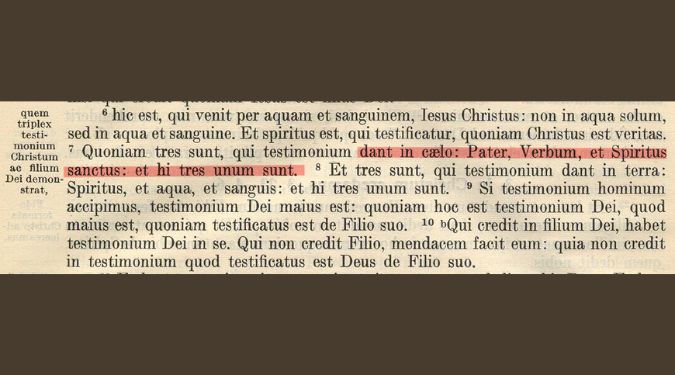Before his conversion to Christianity, the learned St. Augustine had reached a stumbling block, or so he thought. His difficulty lay with passages in the Old Testament that seemed absurd to him. That is, until he heard St. Ambrose preach in Milan. He writes in his Confessions:
I rejoiced also that the old Scriptures of the law and the prophets were laid before me, to be perused, not now with that eye to which they seemed most absurd before, when I censured Your holy ones for so thinking, whereas in truth they thought not so; and with delight I heard Ambrose, in his sermons to the people, oftentimes most diligently recommend this text as a rule— ” The letter kills, but the Spirit gives life; ” while, drawing aside the mystic veil, he spiritually laid open that which, accepted according to the ” letter, ” seemed to teach perverse doctrines— teaching herein nothing that offended me, though he taught such things as I knew not as yet whether they were true.
St. Augustine of Hippo, Confessions:, Book VI, Chapter 4
St. Ambrose introduced St. Augustine to the spiritual sense of scripture.
The senses of scripture were first described by St. John Cassian 360-435, a monk and theologian from a region which is today Romania and Bulgaria. Eventually he lived in a hermitage near Bethlehem and often traveled to the Egyptian desert to converse with the holy monks living there. He recorded his conversations with the monks in a popular book called, “the Conferences” and he describes the four senses in that book in Conference 14, Chapter 8 in a discussion with Abbot Nesteros. They the literal sense and three spiritual senses:
- Literal – The literal sense is the meaning conveyed by the words of Scripture and the sense intended by the inspired human author.
- Allegorical – The allegorical sense gives a deeper understanding of biblical events by recognizing their meaning in Christ, perhaps a hidden or veiled meaning.
- Moral – The moral sense is the meaning that leads us to live a moral life consistent with the gospel.
- Anagogical – the anagogical sense leads us or points toward our true home in heaven and toward the last things.
St. John Chrysostom gives a very simple example of the four senses using the city of Jerusalem:
“ the same Jerusalem can be taken in four senses: historically (that is literally) as the city of the Jews; allegorically as Church of Christ, anagogically as the heavenly city of God ” which is the mother of us all, ” tropologically, as the soul of man,”
The Conferences, Conference 14, Chapter 8
The Catechism of the Catholic Church also provides us with a simple medieval couplet to help us understand these senses: “The Letter speaks of deeds; Allegory to faith; The Moral how to act; Anagogy our destiny.” [CCC 118]
Lastly, St. Thomas Aquinas, in his Summa Theologica, tells us:
the spiritual sense, which is based on the literal, and presupposes it. …Therefore, so far as the things of the Old Law signify the things of the New Law, there is the allegorical sense; so far as the things done in Christ, or so far as the things which signify Christ, are types of what we ought to do, there is the moral sense. But so far as they signify what relates to eternal glory, there is the anagogical sense.
St. Thomas Aquinas, Summa Theologica, I, 1, 10, ad I.
The Church also teaches:
“The literal sense is not to be confused with the “literalist” sense to which fundamentalists are attached. It is not sufficient to translate a text word for word in order to obtain its literal sense. One must understand the text according to the literary conventions of the time. When a text is metaphorical, its literal sense is not that which flows immediately from a word-to-word translation (e.g. “Let your loins be girt”: Luke 12:35), but that which corresponds to the metaphorical use of these terms (“Be ready for action”).
Pontifical Biblical Commission, “The Interpretation of the Bible in the Church” , 1993
That is, in order to determine the literal sense of a particular biblical text, it’s not enough to determine what the words themselves mean. One must ascertain the literary convention it uses, be it historical narrative, allegory, simile, metaphor, hyperbole, or poetry, for example.
Examples of the Spiritual Senses of Scripture
(1) The allegorical sense. The crossing of the Red Sea is a sign or type of Christ’s victory and also of Christian Baptism, and the Manna they ate in the desert is a sign or type of the Eucharist.
I want you to know, brethren, that our fathers were all under the cloud, and all passed through the sea, and all were baptized into Moses in the cloud and in the sea, and all ate the same supernatural food and all drank the same supernatural drink. For they drank from the supernatural Rock which followed them, and the Rock was Christ.
1 Corinthians 10:1-4
(2) The moral sense. The events reported in Scripture ought to lead us to act morally. For example, St. Paul discusses the travails of the Israelites in the desert:
Now these things happened to them as a warning, but they were written down for our instruction, upon whom the end of the ages has come.
1 Corinthians 10:11
(3) The anagogical sense the Church on earth is a sign of the heavenly Jerusalem, as we read in the Book of Revelation:
Then I saw a new heaven and a new earth; for the first heaven and the first earth had passed away, and the sea was no more. And I saw the holy city, new Jerusalem, coming down out of heaven from God, prepared as a bride adorned for her husband; and I heard a loud voice from the throne saying, “Behold, the dwelling of God is with men. He will dwell with them, and they shall be his people, and God himself will be with them; he will wipe away every tear from their eyes, and death shall be no more, neither shall there be mourning nor crying nor pain any more, for the former things have passed away.”
Revelation 21:1-4
The four senses can be considered ways that the Church appropriates the gifts of the Holy Spirit to be found in the Sacred Scriptures. They are like tools in a toolbox or better yet, lenses that we use to read the Bible with the Church.



